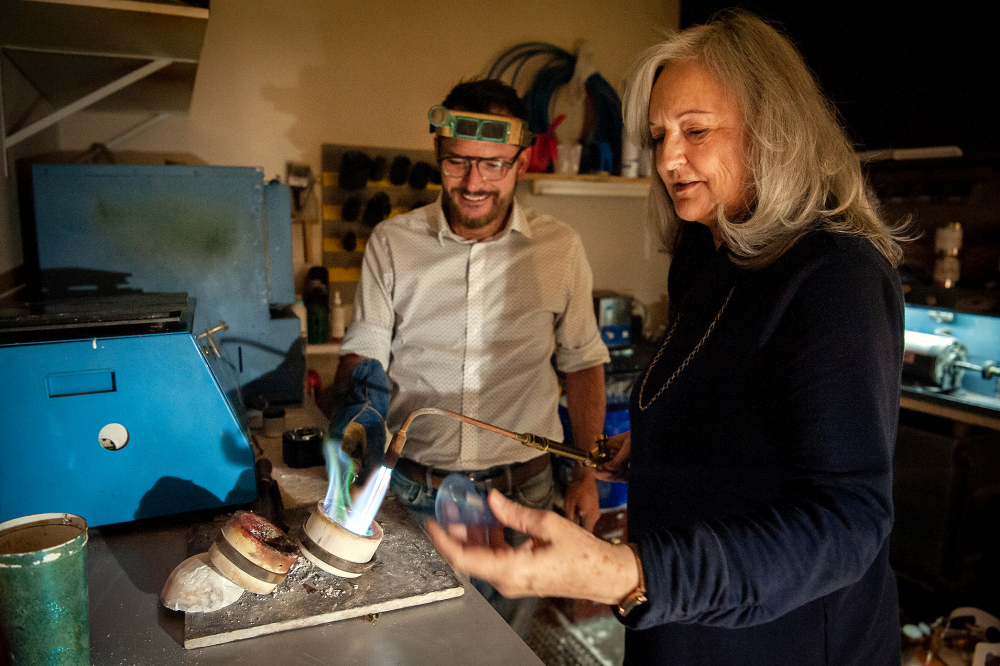Brian Beckham and Martha Scarborough participated in the Mississippi Arts Commission’s 2022-2023 Folk Arts Apprenticeship Program. This grants program supports the survival and continued evolution of community-based traditional art forms. During the apprenticeship, the master artist teaches specific skills, techniques, and cultural knowledge to the apprentice, who is an emerging artist of the same tradition. Participants are awarded $2,000 to assist with the teaching fees for the master artist and other expenses such as travel costs and supplies. To learn more about the program, click here.
Introduction
“Someone once told me that you know you’re a master jeweler when you can fix everything you mess up,” Brian Beckham said. He operates Beckham Custom Jewelry Co. in Jackson, Mississippi, where he and a team of four artists design and fabricate bespoke jewelry. He hired Martha Scarborough to work in his shop as a bookkeeper, but also because of her skills in chainmaille – everyone on his team is some kind of artist. When seeing the repairs, fabrication, and creation that are all done in-house, Martha was keen to learn more and so became his apprentice through the 2022-2023 apprenticeship program.
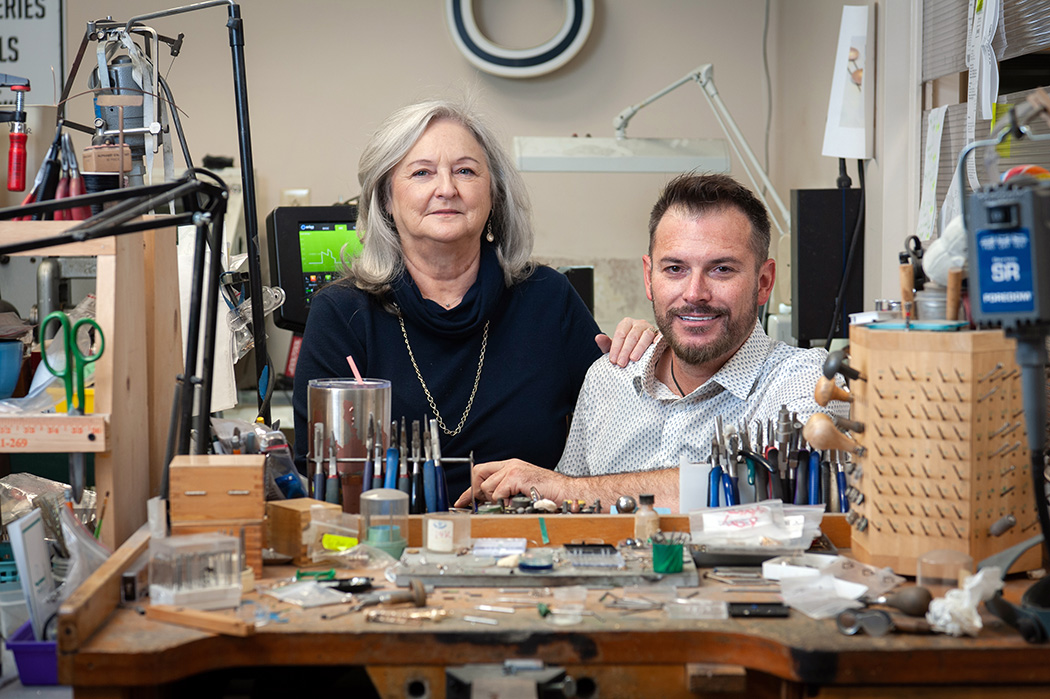
Above (main image): Martha and Brian melting metal in Brian’s workshop
Right: Martha and Brian
All photographs by Rory Doyle.
During their apprenticeship, Doyle took these photos of Brian and Martha at Brian’s shop, Beckham Custom Jewelry Co. in Jackson, MS.
Master Artist: Brian Beckham
Although his great-grandmother pushed him in the arts, the passion did not really fall into place for Brian until he hit the jeweler’s bench. He was first introduced to his craft through his mother, who owned a jewelry store. While working in her store, he fell in love with the creative side of the business and began his education in silversmithing. First, he completed an apprenticeship in Macon, Mississippi where he developed traditional techniques of hand fabrication, casting, and metalsmithing. He studied metalwork at the Memphis School of Art, learning about the composition of metals that are used in making jewelry, the temperature that each melt, and how to join two metal pieces together using a process called soldering. He earned a graduate degree in gemology from Santa Monica’s Gemological Institute of America and studied at the Asian Institute of Gemological Sciences in Bangkok, Thailand. He also studied customization and hand carving in Kansas City and worked for an antique jeweler in New Orleans, absorbing the history of jewelry making while learning restoration and appraising.
Jewelry rarely stands for itself. It represents something. Finding that and getting to it is what’s important to me.
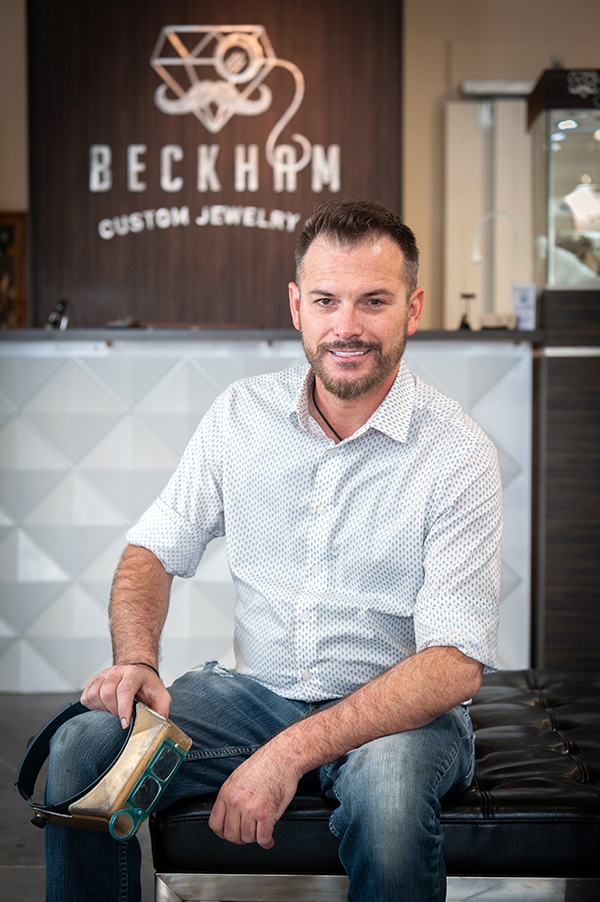
Left: Brian Beckham in his store, Beckham Custom Jewelry Co.
Brian explained that he learned jewelry making “the old way,“ which means employing hand fabrication rather than any electric or mechanized processes. This helped him to acquire a deep respect for the original methods of silversmithing and has remained foundational to his process. He has been in some form of the jewelry business for the past 29 years, whether buying and selling precious stones to designing and making fine jewelry. He added, “Jewelry rarely stands for itself. It represents something. Finding that and getting to it is what’s important to me.”
Apprentice: Martha Scarborough
Mississippi is so diverse in what we have from the Coast to North Mississippi, we have just about every kind of terrain. We have so many natural resources, it’s easy [to draw inspiration].
Martha grew up in Mississippi learning handicrafts like quilting, embroidery, and sewing. She also loved watching her dad repair farm equipment and implements using blacksmithing techniques, which can be similar to silversmithing, as they both involve heating and shaping metals. Martha became interested in making jewelry about twenty-five years ago after she attended a gem and mineral show that featured a demonstration of someone soldering two pieces of metal together. About five years later, she attended a school in Georgia that taught silversmithing and then took several classes from different shops and craftspersons over the years to learn what she calls “the basics.” Martha also said that she advanced her skills by “a lot of practice.” In the twenty years following her first class, Martha worked to become an accomplished chainmaille artist. Chainmaille is an ornate type of jewelry technique “that is like weaving metal rings together into different patterns,” explained Martha. In 2009, she joined the Craftsmen's Guild of Mississippi as a chainmaille artist and has been a part of the guild ever since. She often finds inspiration from fellow guild members as well as watching YouTube videos, being in nature, and observing other artists in Brian’s store.
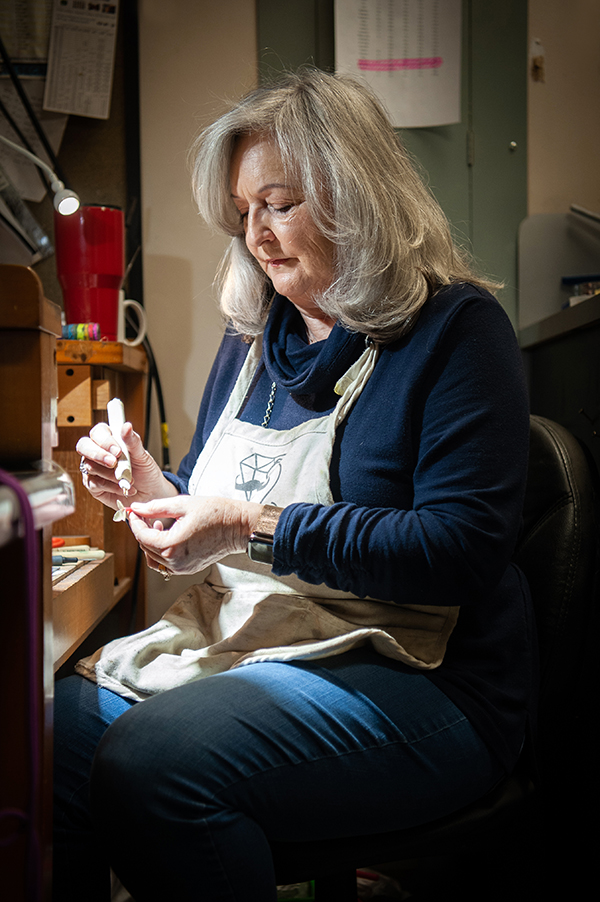
Right: Martha Scarborough
Apprenticeship Experience
Martha had been following the Mississippi Arts Commission for many years and decided to approach Brian about participating in the apprenticeship program. She wanted to learn silversmithing techniques including different ways of soldering silver, torch control, melting methods, finishing techniques, and hand forming metal into jewelry. In observing Brian’s work at his store, Martha realized how the apprenticeship could add other skills to her repertoire. Martha was especially interested in learning more about “making jewelry from scratch.”
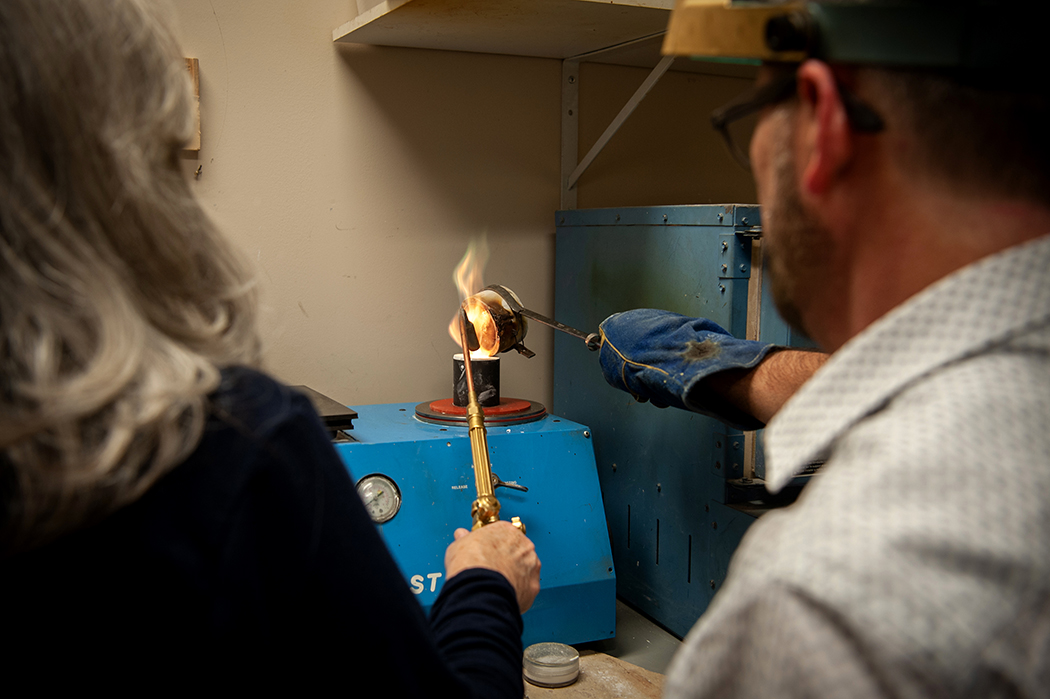
Left: Martha and Brian pouring molten metal
Their meetings were held in the workshop at the back of Brian’s store. The pair started their apprenticeship with lots of talking. They outlined what Martha wanted to learn, her existing skills, and her processes of jewelry making, so Brian could build upon that. They developed their apprenticeship over ten lessons that usually lasted between three to four hours each meeting. The pair’s apprenticeship did not involve working on sample pieces, but instead the majority of the projects that Martha and Brian worked on together were for the store’s line of jewelry inspired by Mississippi’s landscape.
One of their first projects was to create a ring through a method called lost wax casting. The oldest known examples of this method are approximately 6500 years old. “Technically, that technology has not changed since Jesus,” noted Brian. “We have tools that have gotten better and better, but it’s the same process.” Lost wax casting is a method of casting metal from a sculpted piece of wax. When put into a kiln and heated, the wax melts and forms a cavity. Molten metal is then poured into the cavity to create a hand fabricated ring.
In addition to casting, the pair explored other facets of silversmithing. In summarizing her apprenticeship experience, Martha said: “To begin with, I was taught the basics of operating the torch and other tools safely to help prevent accidents. Brian taught me the difference in the types of solder to use and showed me the different techniques of soldering silver beginning with simple rings. I soldered many rings together to make several chains. From there, I was taught to solder components together to create necklace stations. I was then taught the proper techniques to clean up the pieces after soldering using hand tools and a flex-shaft with attachments to make the pieces shiny or to create textures.”
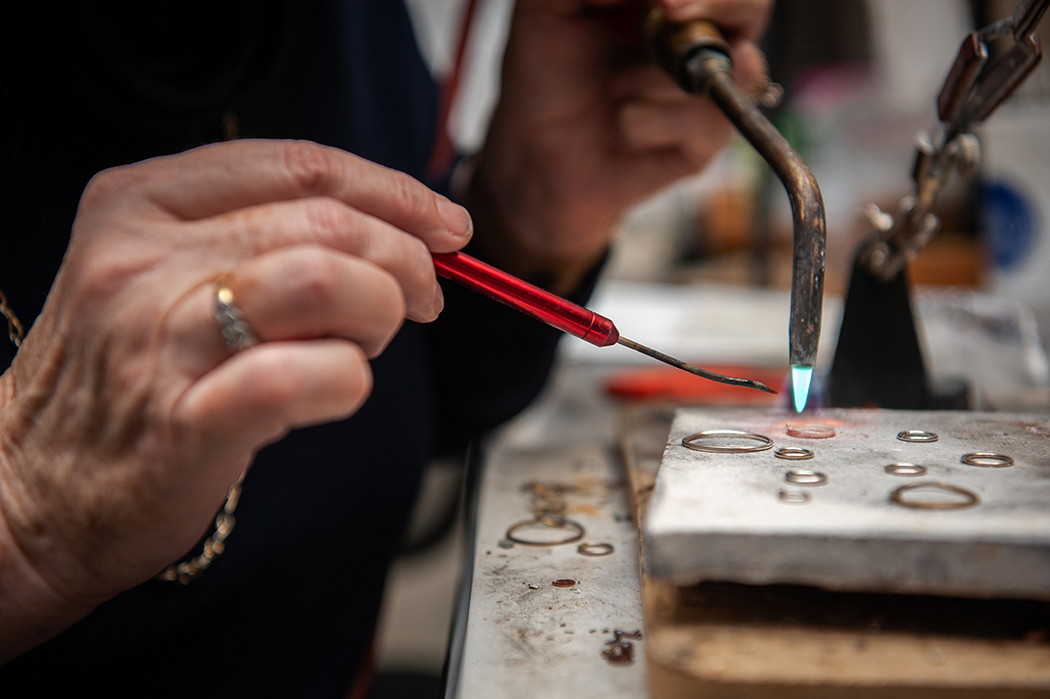
Right: Martha working on metal rings in Brian's workshop
In their lessons and in the shop, Brian and Martha worked well together due to their similar approaches to the craft and their love of nature. “I really like organic styles and natural, flowing things," added Martha. “Mississippi is so diverse in what we have from the Coast to North Mississippi, we have just about every kind of terrain. We have so many natural resources, it’s easy [to draw inspiration].” During their apprenticeship, she experimented with natural forms in her casting including branches, acorn tops, and pistachio nut shells. For example, she made several sets of earrings from pistachio shells.
For [Brian] to have the time to teach me these skills is very rewarding.
He’s gone beyond the lessons.
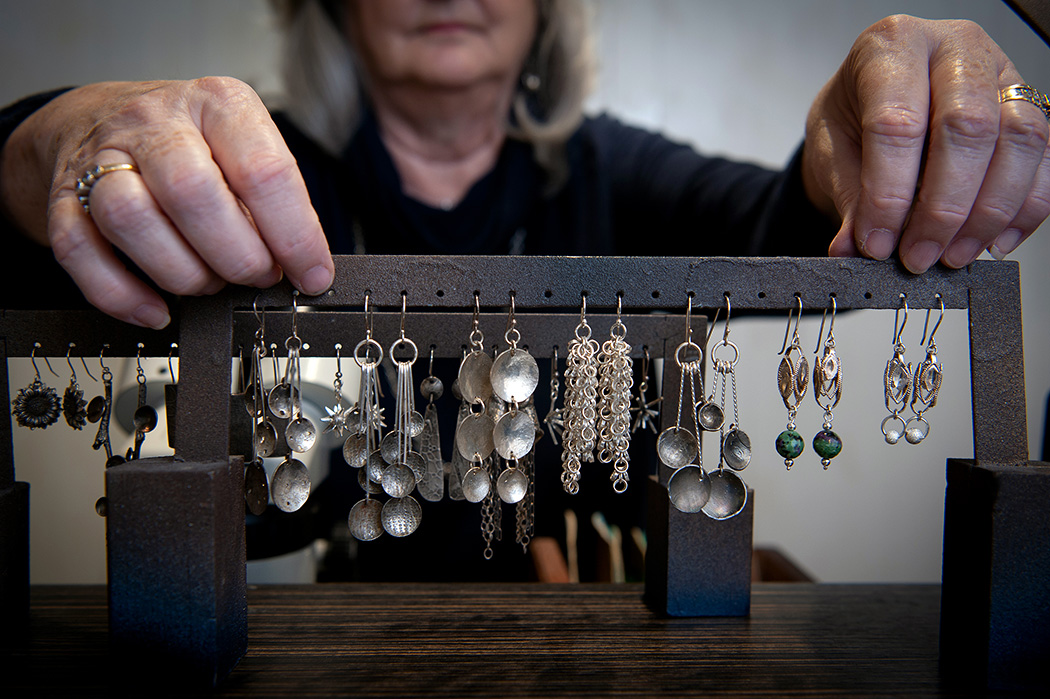
Above: Martha with a collection of her handcrafted earrings
Conclusion
Martha described the apprenticeship as a great partnership. “For [Brian] to have the time to teach me these skills is very rewarding. He’s gone beyond the lessons.” Even after the apprenticeship ended, Brian and Martha have continued to work together. “He’s still teaching me,” said Martha. “I’m [at the shop] to do books, but whenever I’m not busy with that I go and watch Brian, or some of the other artists in the store.” Over the course of the apprenticeship, the pair worked on pieces for two new jewelry lines that they hope to have available by Christmas 2023. In keeping with the pair’s inspirations, the line is “heavily organic and it’s very Mississippi,” explained Brian. Beyond the work for the store, the apprenticeship helped Martha develop her own style of jewelry that incorporates elements of the natural world.
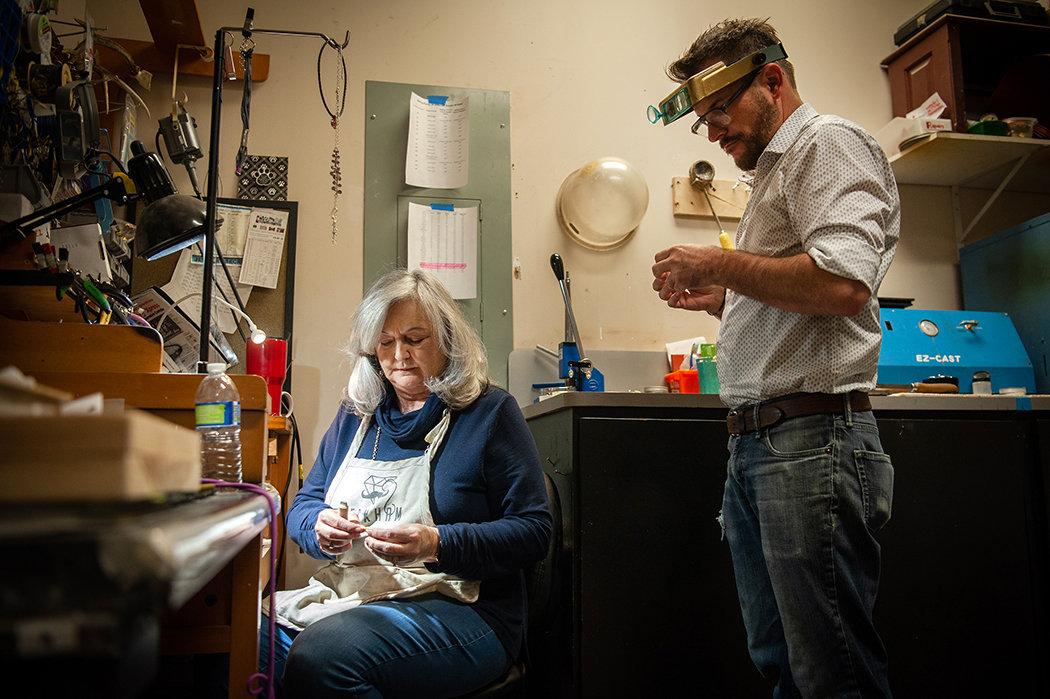
Right: Martha and Brian working together during one of their lessons
“I have been able to learn so much about the art of silversmithing in the short time I worked with Brian. He was so encouraging during the process and was so open to sharing all the techniques he uses in creating his jewelry,” said Martha. “I gained an appreciation for all the time and talent it takes to become an accomplished artist such as him. I also learned that this is an on-going process, and I will always be learning more.” Like Martha, Brian also had a positive experience in the program, and hopes to teach others in the future. “I thoroughly enjoyed sharing that passion with Martha and have watched her develop skills that will help her in creating her own style of jewelry,” added Brian. “She is the go-to when I want a new link design for a chain because she’s really good at that. It’s quite impressive.”
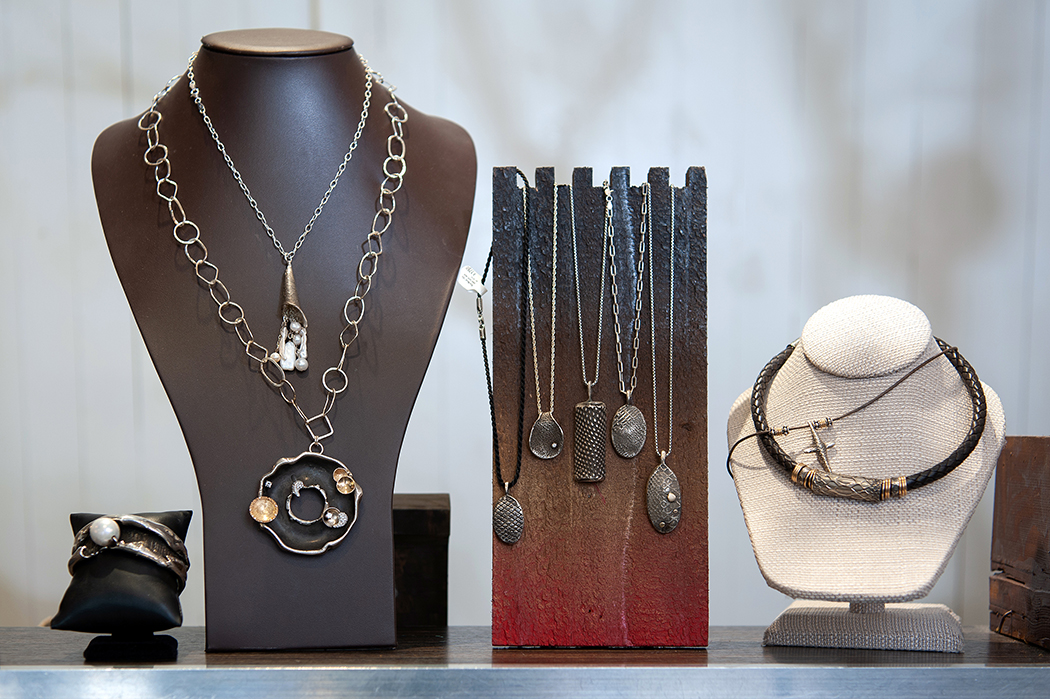
Left: A collection of handmade jewelry that Brian and Martha worked on during the apprenticeship

